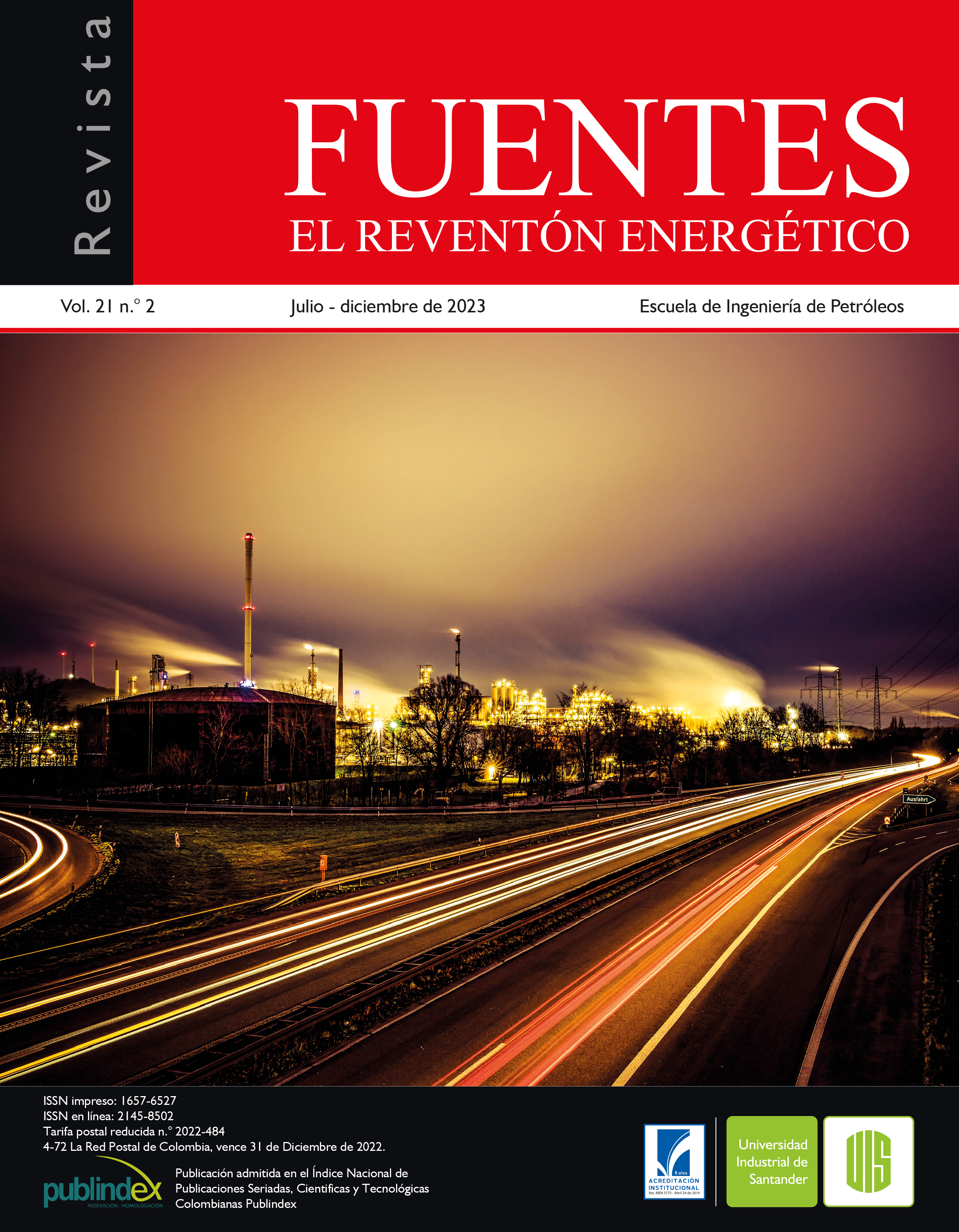EXPERIMENTAL CORRELATION ON INFLUENCE OFTHE COMPOSITION AND TEMPERATURE IN THE STEELS THERMO PHYSICAL PROPERTIES FOR ENGINEERING APPLICATIONS
Published 2023-12-13
Keywords
- Thermo physical Properties,
- Progressive Adjustment Method,
- Generalization of Experimental Data,
- Mean Absolute Error
How to Cite

This work is licensed under a Creative Commons Attribution 4.0 International License.
Abstract
In this work, a predictive method is presented to estimate the variation of three thermo physical properties (thermal diffusivity, specific heat and thermal conductivity) of 32 AISI-SAE commercial classes of rolled and annealed steels, at a working temperature from 0 to 800oC and with a composition (C, Mn, S, P, Ni, Si, Mo, Cr, V). The function adjustment method is used for the treatment and generalization of the available experimental data, obtaining an equation that provides satisfactory fits to extend its use to thermal engineering. The proposed models were verified by comparison with available experimental data. For thermal diffusivity, specific heat and thermal conductivity, the models obtained correlate with a deviation of ±17.6%, ±8.2% and ±16.6%, respectively. The weaker adjustment was achieved in the modelling of the thermal diffusivity of AISI-SAE 316 steel, with a maximum error of 17.6% and a mean absolute error (EMA) of 8.2% in 80.6% of the available experimental data. The best indices were obtained in the estimation of the specific heat of AISI-SAE 1078 steel, with a maximum error of 1.9% and an EMA of 1.1% in 68.3% of the available experimental samples. In all cases, the agreement of the proposed model with the available experimental data is good enough to be considered satisfactory for practical design.
Downloads
References
- Borisade, S.G., Ajibola, O.O., Adebayo, A.O., & Oyetunji, A. (2021). Development of mathematical models for the prediction of mechanical properties of low carbon steel (LCS). Materials Today: Proceedings, 38, 1133-1139. https://doi.org/10.1016/j.matpr.2020.07.134
- Bouissa, Y., Shahriari, D., Champliaud, H., & Jahazi, M. (2019). Prediction of heat transfer coefficient during quenching of large size forged blocks using modeling and experimental validation. Case Studies in Thermal Engineering, 13, 100379. https://doi.org/10.1016/j.csite.2018.100379
- Camaraza-Medina, Y. (2021) Methods for the determination of the heat transfer coefficient in air cooled condenser used at biomass power plants, International Journal of Heat and Technology, 39(5), 1443-1450.https://doi.org/10.18280/ijht.390505
- Camaraza-Medina, Y., Retirado-Mediaceja, Y., Hernandez-Guerrero, A., & Luviano-Ortiz, J.L. (2021). Energy efficiency indicators of the steam boiler in a power plant of Cuba. Thermal Science and Engineering Progress, 23, 100880. https://doi.org/10.1016/j.tsep.2021.100880
- Camaraza-Medina, Y., Hernandez-Guerrero, A., & Luviano-Ortiz, J.L. (2021). New method for the cost assessment analysis of shell-and-tube heat exchangers. Latin American Applied Research, 51(4), 315-320. https://doi.org/10.52292/j.laar.2021.713
- Camaraza-Medina, Y., Hernandez-Guerrero, A., & Luviano-Ortiz, J.L. (2022). Experimental study on influence of the temperature and composition in the steels thermo physical properties for heat transfer applications. Journal of Thermal Analysis and Calorimetry, 147(21), 11805-11821. https://doi.org/10.1007/s10973-022-11410-8
- Gomez, C.F., Van Der Geld, C.W.M., Kuerten, J.G.M., Bsibsi, M., &Van Esch, B.P.M. (2020). Quench cooling of fastmoving steel plates by water jet impingement. International Journal of Heat and Mass Transfer, 163, 120545.https://doi.org/10.1016/j.ijheatmasstransfer.2020.120545
- Khodabakhshi, F., &Kazeminezhad, M. (2011). The effect of constrained groove pressing on grain size, dislocation density and electrical resistivity of low carbon steel. Materials & Design, 32(6), 3280-3286. https://doi.org/10.1016/j.matdes.2011.02.032
- Li, W., Chen, H., Li, C., Huang, W., Chen, J., Zuo, L., Ren, Y., He, J.,& Zhang, S. (2021). Microstructure and tensile properties of AISI 321 stainless steel with aluminizing and annealing treatment. Materials & Design, 205, 109729. https://doi.org/10.1016/j.matdes.2021.109729
- Lieth, H.M., Al-Sabur, R., Jassim, R.J., &Alsahlani, A. (2021) Enhancement of corrosion resistance and mechanical properties of API 5L X60 steel by heat treatments in different environments. Journal of Engineering Research, 9(4B), 428-440. DOI: https://doi.org/10.36909/jer.14591
- Min, K.M., Jeong, W., Hong, S.H., Lee, C.A., Cha, P.R., Han, H.N., & Lee, M.G. (2020). Integrated crystal plasticity and phase field model for prediction of recrystallization texture and anisotropic mechanical properties of cold-rolled ultra-low carbon steels. International Journal of Plasticity, 127, 102644.https://doi.org/10.1016/j.ijplas.2019.102644
- Miranda, G., Faria, S., Bartolomeu, F., Pinto, E., Madeira, S., Mateus, A., Carreira, P., Alves, N., Silva, S. F., & Carvalho, O. (2016). Predictive models for physical and mechanical properties of 316L stainless steel produced by selective laser melting. Materials Science and Engineering: A, 657, 43-56. https://doi.org/10.1016/j.msea.2016.01.028
- Narayana, P.L., Lee, S.W., Park, C.H., Yeom, J.-T., Hong, J.-K., Maurya, A.K., & Reddy, N.S. (2020). Modeling high-temperature mechanical properties of austenitic stainless steels by neural networks. Computational Materials Science,179,109617.https://doi.org/10.1016/j.commatsci.2020.109617
- Peet, M.J., Hasan, H.S., & Bhadeshia, H.K.D.H. (2011). Prediction of thermal conductivity of steel. International Journal of Heat and Mass Transfer, 54(11-12),2602-2608. https://doi.org/10.1016/j.ijheatmasstransfer.2011.01.025
- Roque-Villalonga, G., & Camaraza-Medina, Y. (2022). Modelación empírica de la conductividad térmica para un grupo de aceros. DYNA, 89(224), 156-164. https://dialnet.unirioja.es/servlet/articulo?codigo=8734834
- Şahinoğlu, A., & Rafighi, M. (2021) Investigation of tool wear, surface roughness, sound intensity and power consumption during hard turning of AISI 4140 using multilayer-coated carbide inserts. Journal of Engineering Research, 9(4B), 377-395. https://doi.org/10.36909/jer.8783
- Shi, L., Lin, S.T.K., Lu, Y., Ye, L., & Zhang, Y.X. (2018). Artificial neural network based mechanical and electrical property prediction of engineered cementitious composites. Construction and Building Materials, 174, 667-674.https://doi.org/10.1016/j.conbuildmat.2018.04.127
- Somasundharam, S., & Reddy, K.S. (2020). Inverse analysis for simultaneous estimation of temperature dependent thermal properties of isotropic materials. Thermal Science and Engineering Progress, 20, 100728.https://doi.org/10.1016/j.tsep.2020.100728
- Wang, Z. L., & Adachi, Y. (2019). Property prediction and properties-to-microstructure inverse analysis of steels by a machine-learning approach. Materials Science and Engineering: A, 744, 661-670. https://doi.org/10.1016/j.msea.2018.12.049
- Xie, Q., Suvarna, M., Li, J., Zhu, X., Cai, J., & Wang, X. (2021). Online prediction of mechanical properties of hot rolled steel plate using machine learning. Materials & Design, 197,109201. https://doi.org/10.1016/j.matdes.2020.109201
- Zheng, B., Shu, G., Wang, J., Gu, Y., & Jiang, Q. (2020). Predictions of material properties in cold-rolled austenitic stainless steel tubular sections. Journal of Constructional Steel Research, 164, 105820. https://doi.org/10.1016/j.jcsr.2019.105820
